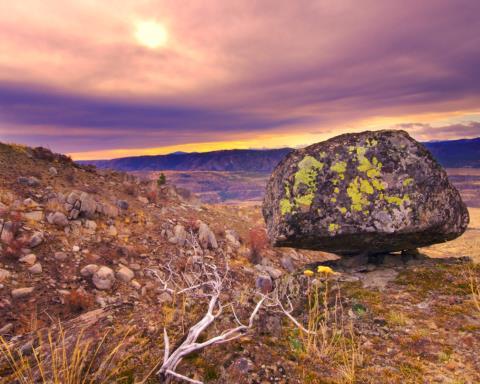
The Chiliwist Unit offers shrubsteppe, wetland, riparian, rocks and cliffs, and forests. It surrounds Chiliwist Creek, which runs west to east through the unit. Popular activities enjoyed here include hunting, hiking, horseback riding, bird watching, and photography.
The Chiliwist Unit is located about 1 mile west of Malott in Okanogan County. The unit can be accessed from Chiliwist Road off of Old Highway 97.
The Chiliwist Unit occurs in the Okanogan Watershed in the Columbia River Basin. Chiliwist Creek flows west to east into the Okanogan River. The unit is surrounded by private, Department of Natural Resources, and Bureau of Land Management lands.
This unit is part of the Sinlahekin Wildlife Area.
Game Management Unit: 239
Getting there
Maps and directions to WDFW-managed access points for this unit. Opens Google Maps in a new tab.
Recreation and public access
A Discover Pass is required on WDFW lands -- including water access areas, wildlife areas, and campgrounds -- unless you already have a Vehicle Access Pass issued with the purchase of an eligible hunting or fishing license. Recreate responsibly on public lands: please know the Public Conduct Rules.
Public facility information:
- Parking area
- Restroom
- Informational kiosk
- Interpretive trail
- Hand-launch boat access
Recreation and access advisories
- Some secondary roads are closed during spring thaw.
- The Carlton Complex Fire burned this entire unit in 2014. Visitors should be cautious of standing burned trees, which could fall at any time.
- Vehicles are restricted to county roads and agency roads not otherwise posted. Seasonal closures may apply to various agency roads to protect resources.
- Visitors are asked to avoid using roads during the wet season.
Hunting
In addition to a healthy mule deer population, the Chiliwist Unit also provides habitat for white-tailed deer, black bears, migratory birds, cougars, badgers, and coyotes. Upland gamebird hunting is a popular activity on the wildlife area, where forest grouse, Hungarian partridge, chukar, quail, and turkey can be found. The area is a release site for ring-necked pheasant.
Hunting advisories
- On all WDFW designated pheasant release sites it is unlawful to possess shot (either in shotshells or as loose shot for muzzleloading), other than nontoxic shot, when hunting for upland game birds (pheasant, quail, chukar, and gray partridge), mourning doves, and band-tailed pigeons (WAC 220-414-040).
Fishing
Historically, eastern brook trout were released in upper reaches of Chiliwist Creek. Access to open water provides trout fishing opportunities.
Fishing advisories
- Chiliwist Creek crosses private property and anglers should pay attention to posted signs
Wildlife viewing
This unit includes shrubsteppe, wetland, riparian, rocks and cliffs, and dry forests, offering opportunities to view a variety of wildlife, including badger, black bear, cougar, coyote, mule and white-tailed deer, chuckar, grouse, Hungarian partridge, wild turkey, quail, and migratory birds.
Search for potential birding opportunities on or near a wildlife area unit by using eBird Northwest, a citizen science database portal that provides freely-shared bird lists at 'hotspots' and interactive maps plus other birding information updated daily.
Other recreational opportunities
This unit offers opportunities for hiking, horseback riding, and nature photography.
Conservation
Habitat types include shrubsteppe, wetland, riparian, rocks and cliffs, and dry forests.
Conservation goals
- Develop a plan to survey and inventory all riparian ecosystems and restore degraded riparian habitat
- Implement the Forest Management Plan which identifies current forest habitats, conditions, and future management needs
- Improve the distribution and abundance of western gray squirrel populations
- Maintain and enhance game and upland bird habitat
- Restore degraded shrubsteppe habitat
Land stewardship
The Chiliwist Unit was purchased primarily for critical mule deer wintering habitat.
Acquisition history
The parcels making up this area were purchased between 1977 and 1979.
| Funder | Fund |
|---|---|
| US National Park Service | Land and Water Conservation Fund |
| WA Recreation and Conservation Office | State Bond Account |
| WA Recreation and Conservation Office | Washington Wildlife and Recreation Program |
Management planning
2017 Scotch Creek and Sinlahekin Wildlife Areas Management Plan
In 2017, the Washington Department of Fish and Wildlife updated the management plan for the Scotch Creek Wildlife Area, which encompasses 23, 980 acres in Okanogan County, and the nearby Sinlahekin Wildlife Area in north central Washington. The plan, called the Scotch Creek & Sinlahekin Wildlife Area Management Plan, addresses the status of wildlife species and their habitat, ongoing restoration efforts and public recreation opportunities at both Scotch Creek and Sinlahekin wildlife areas. Every eight to 10 years, WDFW revises management plans for each of its 33 wildlife areas to document current conditions, address new agency initiatives, and identify new management priorities and actions. In between those major revisions, WDFW updates plans every two years to outline short-term objectives and accomplishments.
Planning Advisory Committee
Okanogan Valley Wildlife Area Advisory Committee